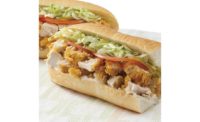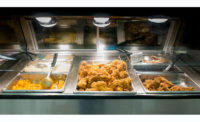For a growing number of meat and poultry shoppers, the “waiting game” at supermarket deli counters is no longer an option.
Indeed, merchandisers seeking to boost department activity must streamline the purchasing process if they are to appeal to the expanding base of convenience- and comfort-oriented deli shoppers, says Russell Zwanka, associate professor, food marketing, in the Department of Marketing at Western Michigan University in Kalamazoo.
Indeed, he notes that operators can lure more shoppers to the increasingly popular self-service cases by expanding their arrays of pre-sliced and pre-packed lunchmeats, which can include having more types of proteins, package sizes and thickness levels, along with additional ready-made sandwiches in the grab and go locations. Enabling consumers to also avoid waits at the deli counter by allowing them to pre-order specialty items via phone apps or in-store kiosks also will boost activity, Zwanka says.
“The deli counter is traumatizing and pressure-filled for many consumers as decisions need to be made quickly,” he says. “Asking for an additional cut of meat while someone is waiting behind you is pressure.”
Many shoppers also perceive the deli service counter to be slow and do not want to wait five to ten minutes to place an order, adds Chris DuBois, senior vice president, protein practice, for Information Resources Inc. (IRI), a Chicago-based market research firm.
The growing popularity of supermarket e-commerce, meanwhile, is creating a potentially powerful sales channel for delis, says Jim Wisner, president of Wisner Marketing, a Gurnee, Ill.-based market research, education and consumer packaged goods consulting firm. He notes that it is crucial that a wide and unique range of meat and poultry options are available online for store pickup or delivery.
“It is essential that online shoppers find what they are looking for,” which includes being able to order meats in the preferred quantity, weight and with the proper thickness, says Eric Richard, industry relations coordinator for the Madison, Wis.-based International Dairy Deli Bakery Association (IDDBA).
Suggestive selling to e-commerce customers, such as emphasizing that rotisserie chickens are available for dinner orders that are picked up between 4 p.m. and 7 p.m., is another strong way to drive sales, notes Anne-Marie Roerink, principal of 210 Analytics LLC, a San Antonio-based market research and marketing strategies firm.
“Retailers are learning more everyday about online operational challenges and will figure out how to make the deli assortment seamlessly available,” she says, which will also enable delis to be more viable competitors of foodservice outlets in the merchandising of prepared meals. “Figure that roughly 10 percent of all food and beverages are sold online these days,” Roerink states. “Making sure that deli meats are proportionally represented is a big opportunity.”







